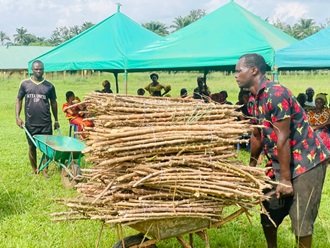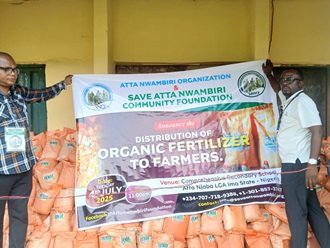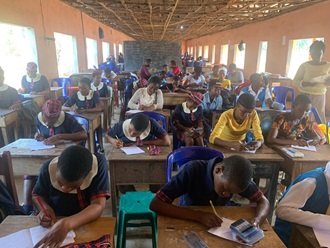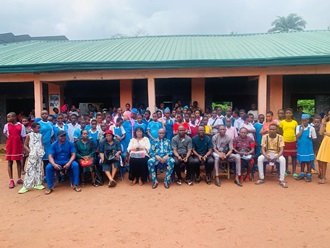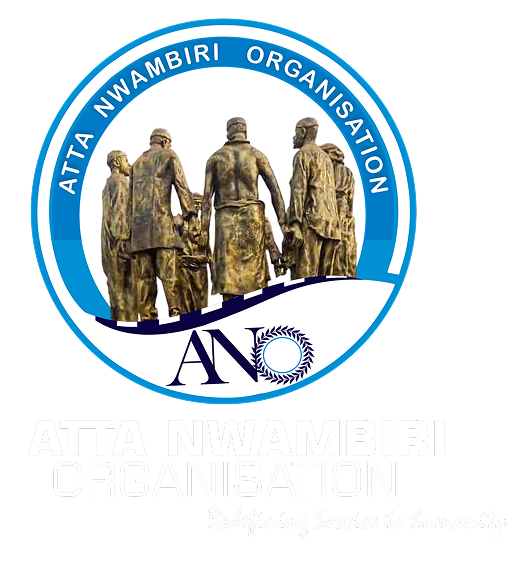EXECUTIVE SUMMARY
This was a project initiated by Save Atta Nwambiri Community Foundation. It was to support farmers in Atta Nwambiritowards resuscitating and sustaining the positive impacts of agriculture and basically crop farming, following the devastating effect of the years of insecurity and killings in the community that saw farmers desert farming for the safety of their lives. To this, hybrid and high yielding cassava stems and maize were bought by the foundation and distributed to the farmers in Atta Nwambiri.
INTRODUCTION
• Background of the project (why it was initiated). On 3rd March 2024, Save Atta-Nwambiri Now had a general meeting during which it was resolved that the local farmers in the ancient kingdom shall be supported to embark on farming this season. Consequently, a team was set to take up the assignment of conducting market survey for the purchase of some farm inputs.
1300 bundles of high yielding cassava hybrid and 210 bags of hybrid maize were purchased and distributed to the farmers.. This took place on 1st May 2024 at Comprehensive Secondary School, Atta. • Goals and objectives.
Save Atta Nwambiri Community Foundation set the following as the goals and objectives of the project.
a) It was aimed at supporting the farmers to offset the losses they incurred during the insecurity;
b) It was a boost to the farmers who have lost interest in crop farming as a result of the insecurity;
c) It was aimed at restoring food security to a people whose sources of sustenance were lost as a result of the insecurity.
d) It was a means of reintroducing AttaNwambiri on the map inland communities where food and farm produce would be accessed at very affordable rate.
e) It acted as a means of informing and assuring the people of Atta Nwambiri and environs that the security is under check.
f) It was an act of assuring and reassuring the people that rebuilding the land of Atta Nwambiri is a very possibility.
• Target beneficiaries (community, demographic, etc.).
The target audience was the local farmers in Atta Nwambiri, made up of three communitues namely Atta, Egwedu and Umunam-Atta. These three communities have 41 villages in all, with women forming not less than 60% of the population. Incidentally, these women constitute the majority of the farmers that engage in the farming of these crops as basic sustenance.
• Geographical coverage.
Atta Nwambiri is part of Njaba Local Government Area Imo State of Nigeria. It covers a land mass of15.625 km² (approx). This covers about 20% of the land mass of Njaba Local Government Area of Imo State.
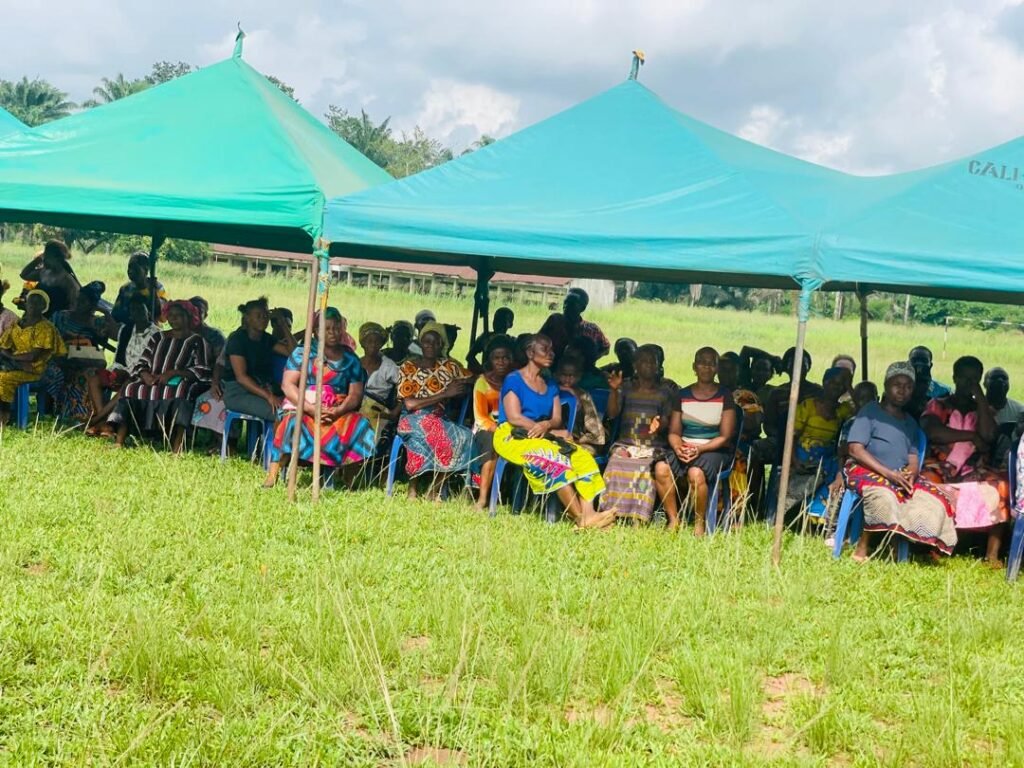
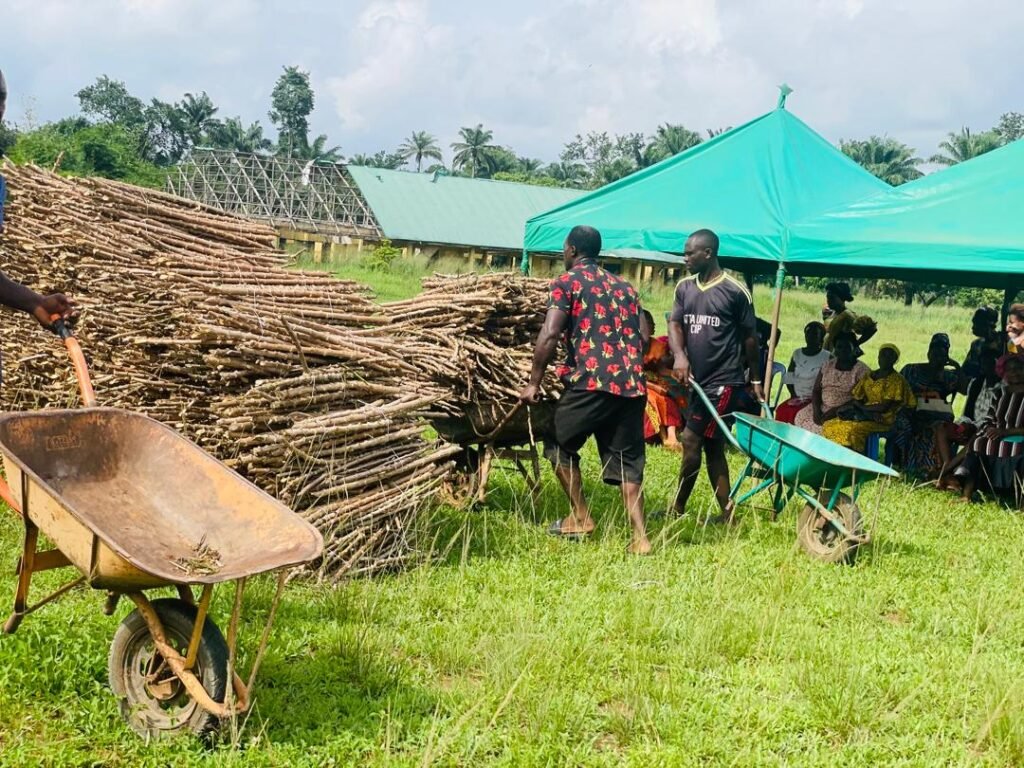
PROJECT ACTIVITIES
• List activities conducted during the reporting period:
Activity 1
On 3rd March 2024:Meeting of SANCF Management, Board and members for approval to support Atta Nwambiri local farmers and set up an adhoc committee for necessary inquiries.
Activity 2
On 17th March 2024:Report of adhoc committee received and approval given for the purchase of hybrid cassava stems and maize. SANCF Engagement Committee mandated to carry on the project.
Activity 3
20th March 2024:Money released for the project.
Activity 4
On 29th March 2024:The committee took delivery of the 210 bags of the hybrid maize.
Activity 5
On 28th April 2024:The committee took delivery of 1300 bundles of cassava stems.
Activity 6
On 1st May, 2024: The farming inputs (maize and cassava stems) were distributed to Atta Nwambiri farmersat Comprehensive Secondary School Atta, where the recipients converged for the distribution.
ACHIEVEMENTS & OUTCOMES
The success of the program was huge. Cassava farming has gained a staple position in the farming business across Atta Nwambiri. The impact of the yikes were quick as predicted. For instance, eight months after the distribution, many families have turned to processing their garri locally. The result from the maize harvest made Atta Nwambiri a market hub for maize buying. • Quantitative results.
1300 Bundles of Cassava stems and 210 bags of hybrid maize seeds were distributed to 41 villages in Atta Nwambiri. The Presidents General of the three communities of Atta, Egwedu and Umunam-Atta, and the villages Chairs received the items in presence of the local farmers. They took the items back to the villages where they were distributed to accommodate even the farmers who could not come to the distribution point.
Before the distribution, Dr Linus Nwuwa, an expert in crop farming and a member of the Engagement Committee, taught the people how to plant, nurture, apply fertilizer, control pests, and harvest the crops for maximum yield. The people asked very crucial questions and they were properly attended to.
• Qualitative impact
The recipients of the items and their representative were thrilled by the unprecedented gesture of SANCF. The Pictorials and videos speak for attest.
CHALLENGES & LESSONS LEARNE
Lack of adequate funding affected the quantity that would make the results sustainably consistent. • Obstacles encountered
The program was initiated when the planting of the two farm inputs were already peeking their planting season, because Atta Nwambiri rely on the normal rainy season for farming.
Lack of adequate funding affected the quantity that would make the results sustainably consistent.
The date for the delivery of the cassava stems as agreed with the supplier was not feasible.
• How challenges were addressed.
Meetings were held without delays and funds released as soon as practicable. The ordering of the inputswere done without delays.
The available fund was judiciously used to provide what is affordable, considering that the program was the first of its kind.
The Engagement Committee wasted no time to distribute the cassava stems considering the fact that the delivery took more than planned.
• Key takeaways for future projects.
Future programs for farming seasons should begin before the farming season.
Increased funding will make the results after the farming season more impactful.
Adding fertilizer to the inputs for the farmers will go a long way to make the anticipated results from the project a huge success.
Intermittent extension services to the farmers will be an added advantage for the success
FINANCIAL SUMMARY
It was a huge success despite the short time from the conception of the idea and it’s realization. • Total budget allocated.
The sum of N4,335,000 (Four Million, Three Hundred and Thirty Five Thousand Naira) was budgeted for the project.
• Funds utilized: The sum of 4,257,000 was spent for the execution of the project. The breakdown is as follows:
Farm inputs –3,885,000
Logistics – 381,600
• Balance remaining
69,000
• (Attach detailed financial rep
MONITORING & EVALUATION
• Methods used for tracking progress (surveys, interviews, field visits).
• Key findings from evaluations.
• Recommendations for improvement.
SUSTAINABILITY & AND FEATURE PLANS
• How the project will be sustained post-funding.
• Plans for scaling up/replicating the project.
• Next steps (if applicable).
CONCLUSION
• Overall reflection on the project’s success.
• Acknowledgment of partners, donors, and stakeholders.
APPENDICES
• Photographs (with captions).
• Case studies/success stories.
• Survey/questionnaire templates.
• Any additional supporting documents.
